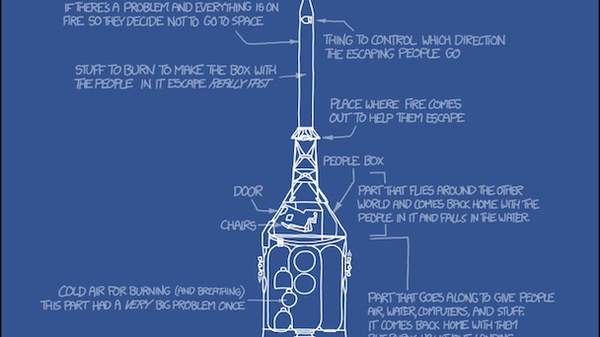Overview
It began, as so many wonderful internet things do, with an XKCD cartoon. Titled Up-Goer Five, the schematic explained the internal workings of the only rocket to have transported humans into space, the Saturn V, using only the 1000 most commonly used words in the English language. Rocket is not one of the words, nor thousand. Nor most of the words in this paragraph.
In the last few days, enabled by Theo Sanderson's specially built text editor, several other people have Up-Goer Fived their own area of expertise. Most of them are scientists from esoteric fields, giving us laymen a rare chance to grasp what their life's work is about. Not being able to use jargon makes for some convoluted WTF gibberish sentences, but at other, better times, it creates windows where you can grasp at some previously ungraspable idea.
Check out these excerpts and their simply stated insights.
1. Saturn's moon Iapetus is two-toned because bits of air turn into ice on the back side of it
"First, it runs into black stuff that sticks to the front of it. That black stuff takes in more light from the sun and makes it warmer. That makes very tiny bits of the ice it's made of turn into air, and the bits of air go around it and turn back into ice on the back side of it. Second, when the bits of ice go away from the front side, they leave behind dark stuff that was between and under them, and that makes the front side even blacker, and helps it warm up even more, so things go on and on and on. The back side is white because it didn't get black stuff on it, and also because the ice that went away from the black side went there and made it bright."
By Rachel Klippenstein. Read in full at io9.com.
2. The Higgs boson is the tiny thing that makes all other things heavy
"What makes the tiniest things heavy? The best guess explained this by saying that all around us is a field, which is a bit like water or some other stuff that would slow you down if you tried to walk through it … [U]ntil last year, people weren’t completely sure this field was real. But they knew that if it was real, and you shook it really hard, then a totally new tiny thing would fall out of it. That’s because it’s a bit like the water-like-stuff is made out of this new tiny thing."
By Michael Slezak. Read in full here.
3. We don't have robot helpers yet because it's hard to make computers with bodies walk
"We want the computers with bodies to run quickly. We want them to climb walls. We need them to do these things even when the ground is covered in rocks or with ice, without tripping and falling or getting stuck. We look a lot at animals to see how they do these things. We try to understand how their brain decides where to put their legs, and how their legs are built."
By Shira E. Read in full here.
4. The Bechdel Test is a check to see if things are even in the way they show men and women
"To make the story as much like real life as possible (except for the made-up bits) you really do need a lot of different kinds of people, not just lots of men who are quite like each other because they are all young and white and strong. This makes it easier for people to accept the really made up bits, because the rest of the story feels much more real."
Read in full here.
5. Environmental protection might mean not giving so much food to animals and cars
"So how are we going to grow more food without cutting down more trees? One answer to this problem is looking at how we use the food we grow today. People eat food, but food is also used to make animals and run cars. In fact, animals eat over one-third of the food we grow."
By Emily S. Cassidy, environmental scientist. Read in full here.
6. Postmodernism is that many things we think are facts are actually stories
"This is not to say the facts are not true. But the story isn't."
Read in full here.
